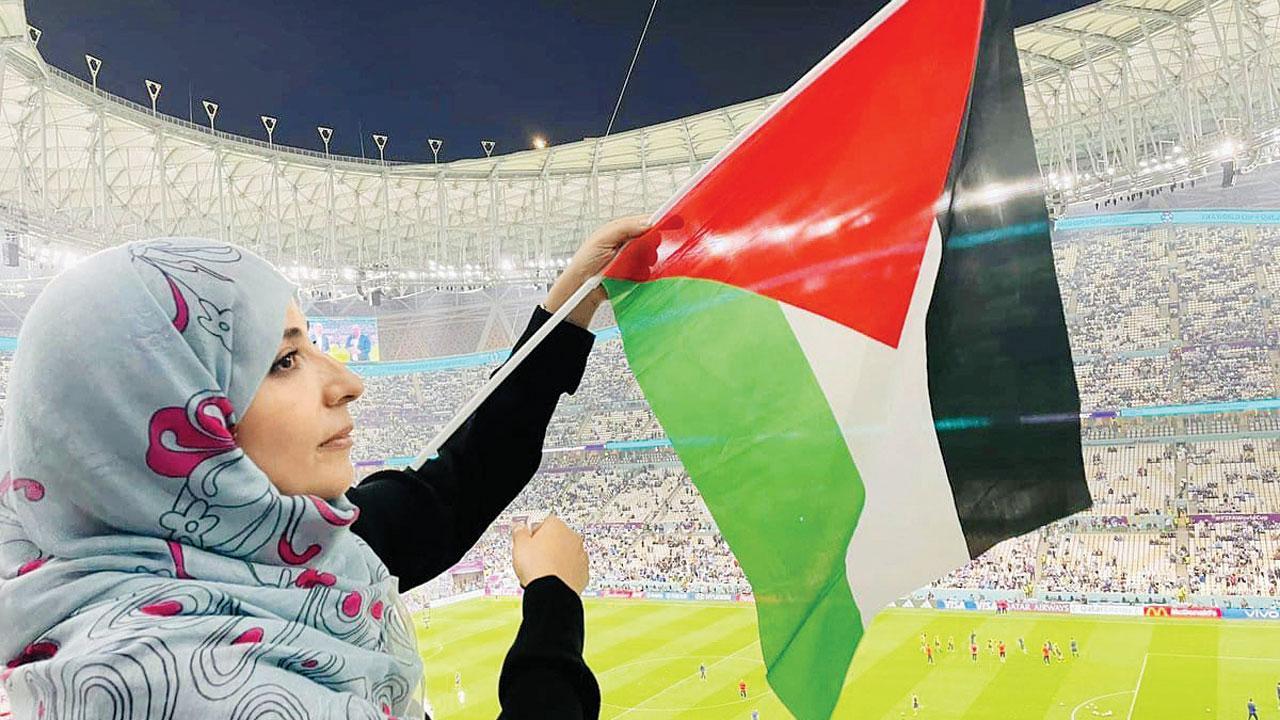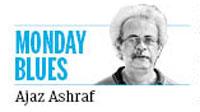Israel has taken away the land and freedom of Palestinians, who have refused to be invisibilised, by producing literature, tossing bombs, pelting stones, or flying their flag, as they did in Qatar

A woman waves the Palestine flag during a match at the FIFA World Cup. Pic/Twitter
 Palestine had a ghost-like presence in the FIFA World Cup, with its flag popping up just about everywhere in Qatar. The popular fervour for Palestine was ascribed to the anger of Arabs at Israel ruling over the “Occupied Territories”—comprising the West Bank, the Gaza Strip and East Jerusalem—as ruthlessly as any colonial power.
Palestine had a ghost-like presence in the FIFA World Cup, with its flag popping up just about everywhere in Qatar. The popular fervour for Palestine was ascribed to the anger of Arabs at Israel ruling over the “Occupied Territories”—comprising the West Bank, the Gaza Strip and East Jerusalem—as ruthlessly as any colonial power.
ADVERTISEMENT
Not just the Occupied Territories, the entire Israel is a usurpation.
The creation of Israel in Palestine was conceived by the Zionist movement, which emerged in the 1880s. Between 1909 and 1914, about 40,000 Jewish immigrants trickled into Palestine. They were settled on land purchased by the Zionist movement. To these settlers, the native Palestinians “were largely invisible…or, if not, were part of nature’s hardship and as such were to be conquered and removed,” writes Ilan Pappé, in The Ethnic Cleansing of Palestinians.
The first step in this direction was the 1917 Balfour Declaration, made in the backdrop of Britain’s imminent victory over the Ottomans in Palestine. The Declaration said the British government viewed favourably the “establishment in Palestine of a national home for the Jewish people” but without prejudicing the “existing civil and religious rights of existing non-Jewish communities” there.
Also read: Ind v Aus here…so long ago!
The Declaration invisibilised the Arabs. Rashid Khalidi, in The Hundred Years’ War on Palestine, writes, “The overwhelming Arab majority of population went unmentioned by Balfour, except in a backhanded way as the ‘existing non-Jewish communities in Palestine.’” The recognition of the national rights of the Jewish people gave a fillip to their immigration, which saw them grow from being six per cent of Palestine’s population in 1918 to 18 per cent in 1926.
In 1918 itself, 33 exiled Palestinians protested to the British Office against the plan to convert their country into a national home for the Jews. Their protest was to no avail, with the League of Nations mandate, issued to the British in 1922 for administering Palestine, reiterating the Balfour Declaration.
The rise of the Nazis in Germany saw 65,000 Jews pour into Palestine in 1935 alone, prompting Zionist leader David Ben-Gurion to purr, “Immigration at the rate of 60,000 a year means a Jewish state in all Palestine.” Bankrolling the immigration was an agreement between the Zionists and the Nazi government that allowed Jews to transfer $100 million out of Germany. In 1936, the Jews were now over 28 per cent of Palestine’s population.
In 1937, the British-appointed Peel Commission envisaged a Jewish state in 17 per cent of the Palestinian territory. The Arabs revolted, only to be brutally crushed by the Mandatory Administration two years later. Around 10 per cent of Palestinians were killed, wounded, imprisoned, or exiled. Khalidi rates Britain’s armed suppression of the revolt as the most invaluable service it provided to the Zionist movement, as it weakened the Palestinians for future battles.
The discovery of the horrors of the Holocaust had the world perceive the Jews as the foremost victims of World War II. This global sympathy became a justification for the United Nations, through its resolution of November 29, 1947, to divide Palestine and give 56 per cent of its territory to the Jews. Next day, armed conflict broke out, with poorly armed Palestinians failing to match the colonisers, who, on May 14, 1948, declared the formation of Israel. Palestinians commemorate May 15 as the Nakba, or Great Catastrophe. In the next phase of the Nakba, Israel defeated the Arab regimes belatedly interceding in the conflict on Palestine’s behalf.
Israel now possessed 78 per cent of former Mandatory Palestine. The remaining 22 per cent comprised the Gaza Strip, which Egypt occupied, and the West Bank, which Jordan took over. Nearly 800,000 of the 1.3 million Palestinians were compelled to become refugees. Historians like Pappé have cited documents to show that the expulsion of Palestinians was nothing less than ethnic cleansing planned by a group of eleven, comprising veteran Zionist leaders and young Jewish military officers.
Cut to 1967: To stop Israel from diverting water from the Jordan river to central parts of Israel, Fatah, one of the militant Palestine groups, attacked a water pumping station in central Europe. This symbolic action mounted popular pressure on the reluctant Arab regimes to take action against Israel. Egypt transferred 60,000 troops to the Sinai Peninsula.
Dubbing it as a provocation, Israel struck first, neutralising the air power of Egypt, Jordan and Syria. Israel’s strike had the approval of America, although it believed the three countries did not pose an existential threat to Israel, which won the war in six days in June 1967. It seized the Gaza Strip and the Sinai Peninsula from Egypt, the West Bank, including East Jerusalem, from Jordan and the Golan Heights from Syria.
The Occupied Territories of the West Bank, the Gaza Strip and East Jerusalem have been denied their freedom even three decades after the flawed Oslo Accords seemed to have held out such a promise. Late public intellectual Edward Said once said, “The best Palestinian for them [Israel] is either dead or gone.” In exile or living in the Occupied Territories, the Palestinians have refused to be invisibilised, by producing literature, tossing bombs, chucking stones, or simply flying their flag in the FIFA World Cup.
The writer is a senior journalist.
Send your feedback to mailbag@mid-day.com
The views expressed in this column are the individual’s and don’t represent those of the paper.
 Subscribe today by clicking the link and stay updated with the latest news!" Click here!
Subscribe today by clicking the link and stay updated with the latest news!" Click here!







